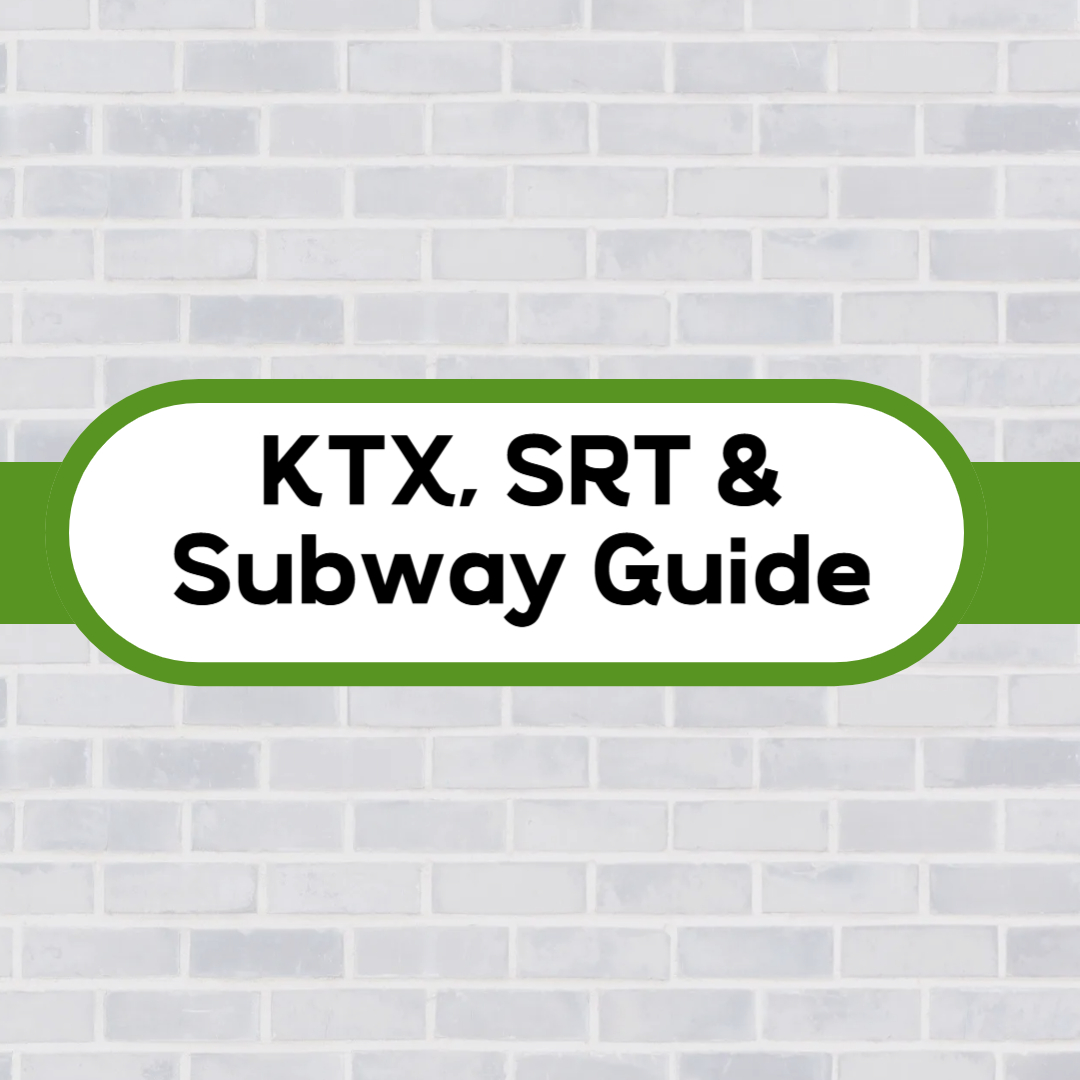
When visiting Korea for travel or business, using fast and convenient transportation is essential. KTX, SRT, and subway are the most popular public transportation options in Korea, each with its own features and advantages. In this article, we will introduce how foreign travelers can efficiently use KTX, SRT, and the subway, and explain the key differences between them, along with the routes, departure, and arrival stations.
1. KTX (Korea Train Express) - Korea's High-Speed Train
KTX is Korea's flagship high-speed rail service that connects Seoul to major cities across the country. Operated by KORAIL, it reaches speeds of up to 300 km/h, making it possible to travel from Seoul to Busan in just about 2.5 hours. For foreign travelers, KTX offers the most convenient option for long-distance travel within Korea.
Key Departure and Arrival Stations
- Seoul: Seoul Station, Express Bus Terminal Station
- Busan: Busan Station
- Daejeon: Daejeon Station
- Daegu: Daegu Station
- Gwangju: Gwangju Songjeong Station
KTX connects major cities such as Seoul ↔ Busan, Seoul ↔ Daejeon, Seoul ↔ Daegu, and Seoul ↔ Gwangju, making it ideal for traveling across the country. The Seoul → Busan route is particularly popular and widely used by tourists and business travelers alike.
How to Book KTX Tickets
You can book KTX tickets through the KORAIL official website (www.letskorail.com) or the KORAIL Talk mobile app. On these platforms, you can select your departure and arrival stations, choose your travel date and time, and reserve your seat. The websites and apps are available in English and Chinese, making it easy for non-Korean speakers to book tickets.
2. SRT (Super Rapid Train) - Another High-Speed Train Option
The SRT is another high-speed train operated by SR Corporation (Super Rapid Train), which provides a similar service to KTX. The key difference is that the SRT departs from Suseo Station rather than Seoul Station. While both KTX and SRT operate on similar routes, the SRT may be a more affordable option.
Key Departure and Arrival Stations
- Seoul: Suseo Station (connected to Seoul Subway Line 3)
- Busan: Busan Station
- Daejeon: Daejeon Station
- Daegu: Dongdaegu Station
- Gwangju: Gwangju Songjeong Station
The SRT operates on routes like Seoul → Busan, Seoul → Daejeon, and Seoul → Daegu, offering a fast and efficient way to travel across Korea. The Seoul → Busan route takes about 2.5 hours, just like the KTX.
How to Book SRT Tickets
You can book SRT tickets through the SRT official website (www.srail.or.kr) or the SRT mobile app. The process is similar to KTX booking, allowing you to choose departure and arrival stations, travel dates, and seat preferences.
3. Subway - The Heart of Urban Transportation
The subway is the most widely used mode of transportation in major cities like Seoul, Incheon, and Busan. The Seoul Subway has 9 lines (Line 1 through Line 9) that connect various neighborhoods and attractions. The subway is especially useful for foreign travelers visiting popular tourist spots like Gyeongbokgung Palace, Myeongdong, and Hongdae.
Key Lines and Areas
- Seoul: Seoul Station, Gangnam Station, City Hall Station, Hongdae Station, etc.
- Incheon: Incheon Subway Line 1, Line 2
- Busan: Busan Subway Line 1, Line 2, Line 3
- Daegu: Daegu Subway Line 1, Line 2
- Gwangju: Gwangju Subway Line 1, Line 2
The Seoul Subway is ideal for short-distance travel within the city and is convenient for visiting major tourist destinations, shopping districts, and restaurants. The Gangnam ↔ City Hall route is one of the busiest and most popular during rush hours.
How to Use Subway and Buy a Transportation Card
For the subway, you don’t need to make reservations, but you’ll need to use a transportation card to pay for your ride. The most commonly used cards are the T-money card and Cashbee card, both of which can be purchased at convenience stores or subway stations. After buying a card, you can load it with money and use it to pay for your subway rides, buses, and even taxis.
The T-money and Cashbee cards work on all major public transport systems, including buses, subways, and even some taxis, making it a convenient all-in-one option for foreign travelers.
KTX, SRT, Subway Comparison |
|||
| Feature | KTX | SRT | Subway |
| Operator | KORAIL (Korea Railroad Corporation) |
SR Corporation (Super Rapid Train) |
Seoul Metro |
| Key Routes | Seoul ↔ Busan, Seoul ↔ Daejeon, Seoul ↔ Daegu |
Seoul ↔ Busan, Seoul ↔ Daejeon, Seoul ↔ Daegu |
Seoul, Incheon, Busan, Gwangju, Daegu |
| Speed | Up to 300 km/h | Up to 300 km/h | Average speed: 40-70 km/h |
| Departure | Seoul Station, Express Bus Terminal |
Suseo Station | Seoul Station, Gangnam Station, City Hall Station |
| Price | Relatively expensive | Slightly cheaper than KTX | Very affordable (with transportation card) |
| Main Features | Long-distance high-speed travel | Fast, affordable option from Suseo Station |
Convenient urban transport for sightseeing and shopping |
Conclusion
Korea's public transportation system makes it easy for foreign travelers to get around efficiently. KTX and SRT are excellent options for fast, long-distance travel, connecting major cities with high-speed trains. On the other hand, the subway is perfect for traveling within the city, especially for visiting key tourist attractions and shopping districts. By using these transportation systems, you can save time and have a hassle-free experience during your trip to Korea.
* KTX Booking Link: 레츠코레일-LetsKorail Website
* SRT Booking Link: 승차권 예약/발매 - 국민철도 SR
* Seoul Metro Information: 서울교통공사 Website